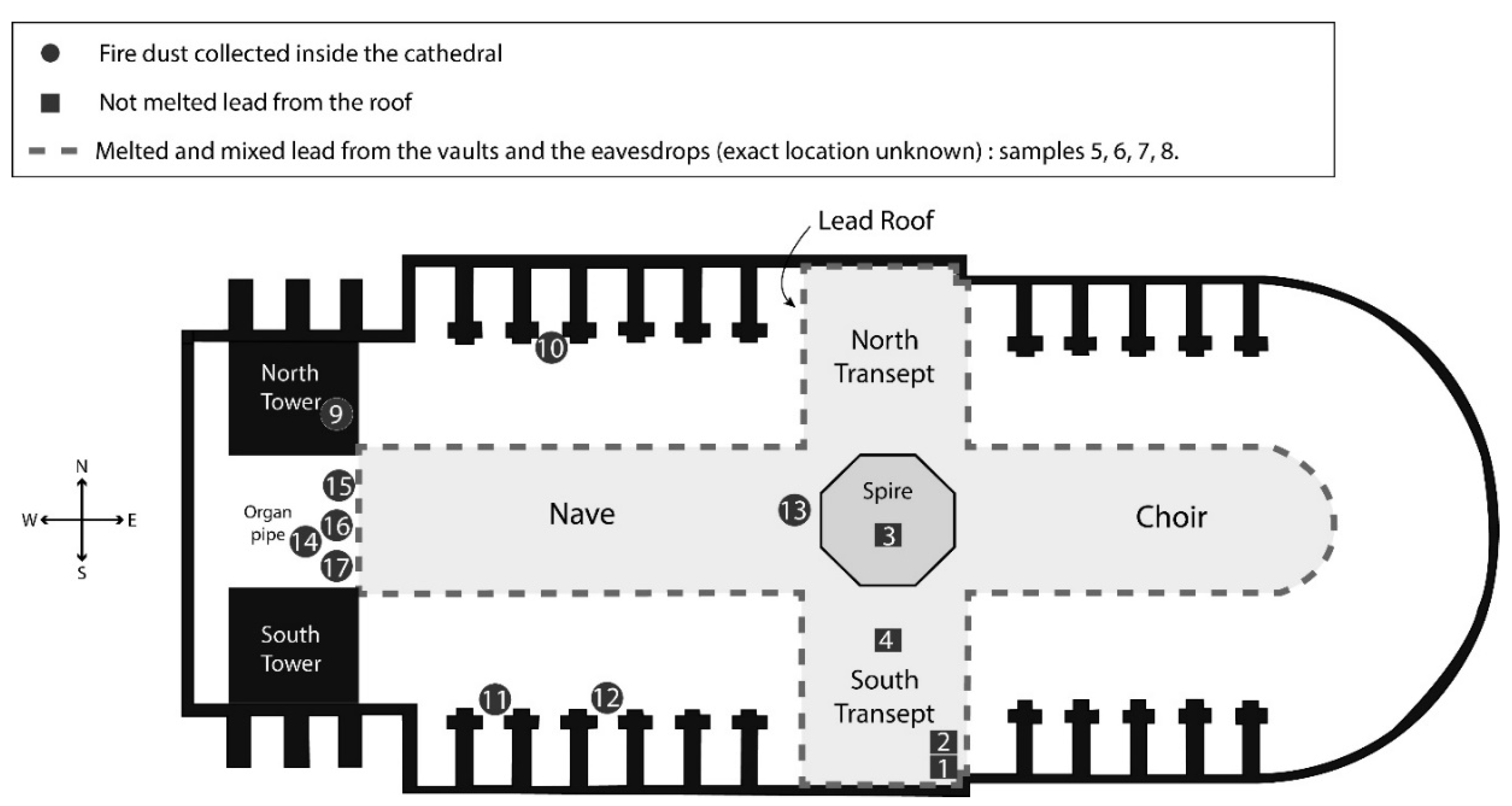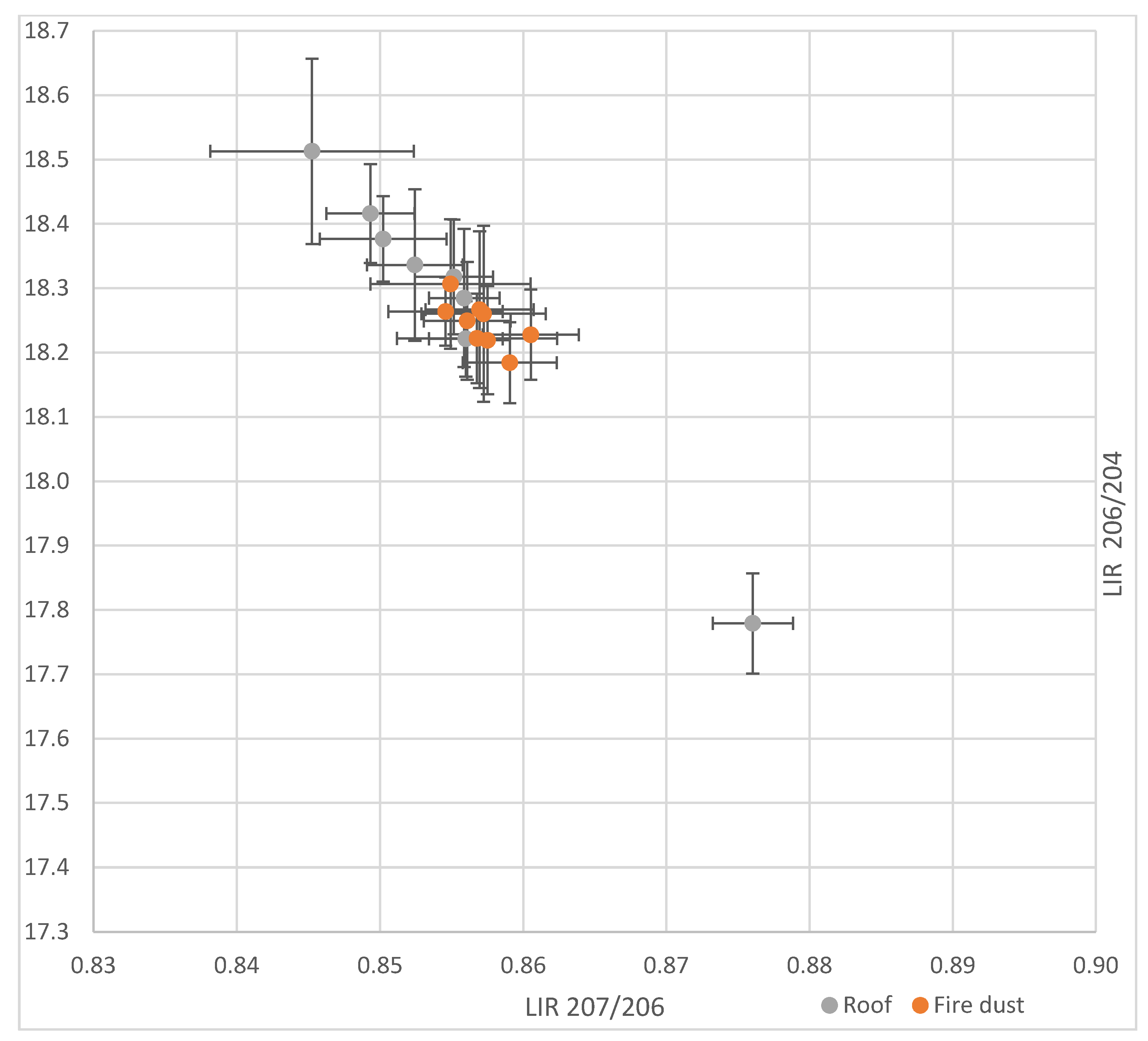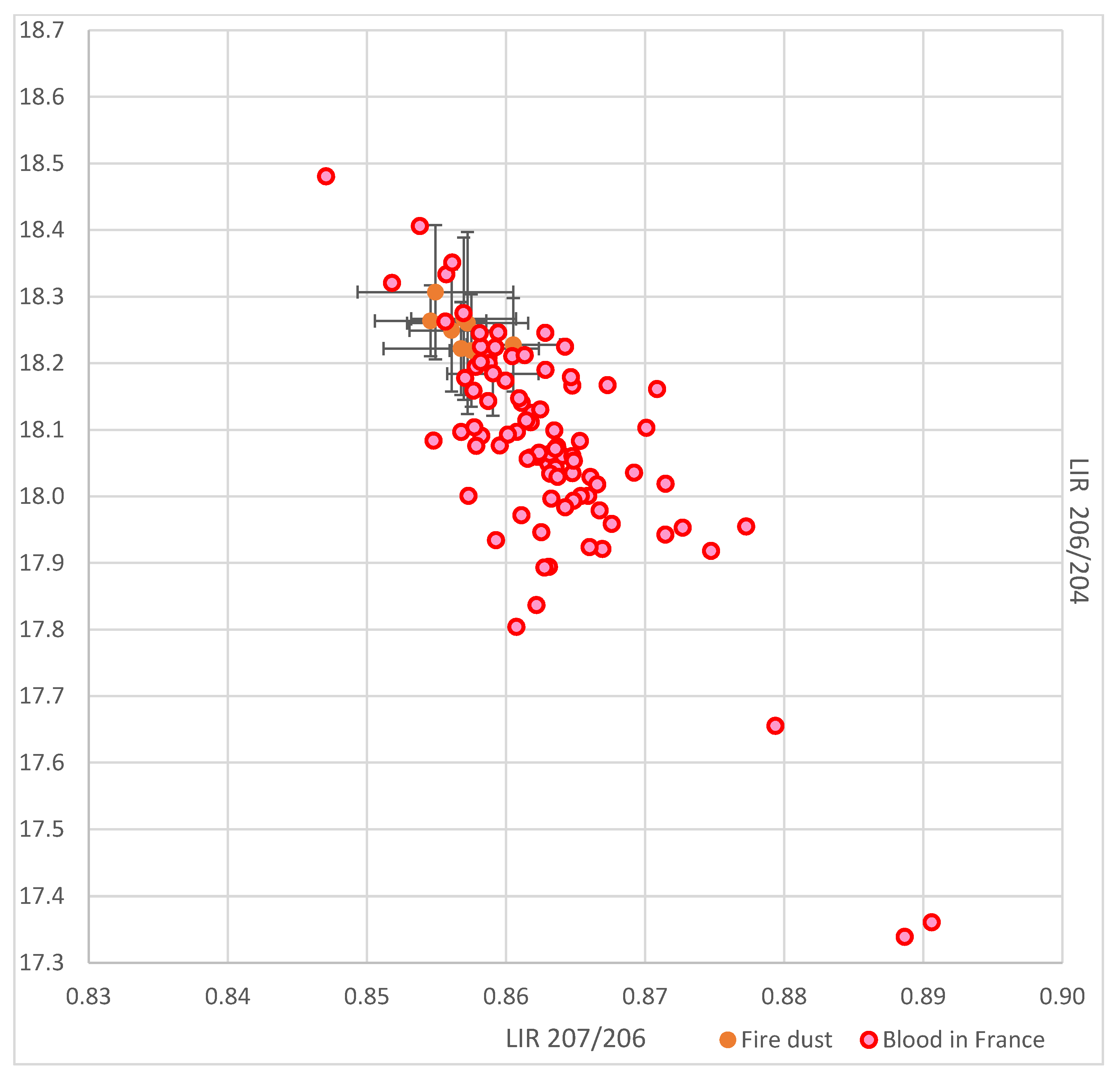The Isotopic Signature of Lead Emanations during the Fire at Notre Dame Cathedral in Paris, France
Abstract
1. Introduction
2. Materials and Methods
2.1. Study Design
2.2. Sample Collection
2.3. Sample Analysis
2.3.1. Materials and Reagents
2.3.2. Sample Pre-Treatment
2.3.3. Lead Solubilization
2.3.4. ICP/MS Analysis
- IR—Isotopic Ratio;
- IR sample—uncorrected Isotopic Ratio;
- IR Std θ—Isotopic Ratio of SRM 981 certified;
- IR Std1—Isotopic Ratio of SRM 981 analyzed before the sample;
- IR Std2—Isotopic Ratio of SRM 981 analyzed after the sample;
- SD—Standard deviation;
- SD sample—Uncorrected standard deviation;
- SD Std 1—Standard deviation of SRM 981 analyzed before the sample;
- SD Std 2—Standard deviation of SRM 981 analyzed after the sample.
2.4. Isotopic Ratio Interpretation
3. Results
4. Discussion
5. Conclusions
Supplementary Materials
Author Contributions
Funding
Institutional Review Board Statement
Informed Consent Statement
Data Availability Statement
Acknowledgments
Conflicts of Interest
References
- Tognet, F.; Truchot, B. Modélisation de la Dispersion des Particules de Plomb du Panache de L’incendie de Notre Dame, Ineris-200480-879062-v2.0; Institut National de L’environnement Industriel et des Risques: Verneuil-en-Halatte, France, 2019. [Google Scholar]
- Van Geen, A.; Yao, Y.; Ellis, T.; Gelman, A. Fallout of lead over Paris from the 2019 Notre-Dame cathedral fire. GeoHealth 2020, 4, e2020. [Google Scholar]
- Azéma, A. Cathédrale Notre-Dame de Paris-Grand-orgue-étude des Poussières Déposées sur deux Tuyaux D’orgue Suite à L’incendie du 15 Avril 2019; Laboratoire de Recherche des Monuments Historiques: Champs-sur-Marne, France, 2019. [Google Scholar]
- Anonymous. Incendie de Notre-Dame de Paris: Bilan à 6 Mois; Préfecture de Paris et d’Île-de-France & Agence Régionale de Santé d’Île-de-France: Paris, France, 2019; p. 21. [Google Scholar]
- Oulhote, Y.; Le Bot, B.; Deguen, S.; Glorennec, P. Using and interpreting isotope data for source identification. TrAC Trends Anal. Chem. 2011, 30, 302–312. [Google Scholar] [CrossRef]
- Gwiazda, R.H.; Smith, D.R. Lead isotopes as a supplementary tool in the routine evaluation of household lead hazards. Environ. Health Perspect. 2000, 108, 1091–1097. [Google Scholar] [CrossRef] [PubMed]
- Glorennec, P.; Peyr, C.; Poupon, J.; Oulhote, Y.; Le Bot, B. Identifying sources of lead exposure for children, with lead concentrations and isotope ratios. J. Occup. Environ. Hyg. 2010, 7, 253–260. [Google Scholar] [CrossRef] [PubMed]
- Elburg, M.; Vroon, P.; van der Wagt, B.; Tchalikian, A. Sr and pb isotopic composition of five usgs glasses (bhvo-2g, bir-1g, bcr-2g, tb-1g, nkt-1g). Chem. Geol. 2005, 223, 196–205. [Google Scholar] [CrossRef]
- Oulhote, Y.; Le Bot, B.; Poupon, J.; Lucas, J.P.; Mandin, C.; Etchevers, A.; Zmirou-Navier, D.; Glorennec, P. Identification of sources of lead exposure in french children by lead isotope analysis: A cross-sectional study. Environ. Health 2011, 10, 75. [Google Scholar] [CrossRef] [PubMed]
- Gulson, B.; Kamenov, G.D.; Manton, W.; Rabinowitz, M. Concerns about Quadrupole ICP-MS Lead Isotopic Data and Interpretations in the Environment and Health Fields. Int. J. Environ. Res. Public Health 2018, 15, 723. [Google Scholar] [CrossRef] [PubMed]
- Ayrault, S.; Roy-Barman, M.; Le Cloarec, M.-F.; Priadi, C.R.; Bonté, P.; Göpel, C. Lead contamination of the seine river, france: Geochemical implications of a historical perspective. Chemosphere 2012, 87, 902–910. [Google Scholar] [CrossRef] [PubMed]
- Smith, K.E.; Weis, D.; Chauvel, C.; Moulin, S. Honey maps the pb fallout from the 2019 fire at notre-dame cathedral, paris: A geochemical perspective. Environ. Sci. Technol. Lett. 2020, 7, 753–759. [Google Scholar] [CrossRef]
- Daussy, S.D. Mise en œuvre d’une toiture et idée d’architecture. Le cas de Notre-Dame de Paris, In L’idée d’architecture médiévale au Japon et en Europe; Masatsugu, N., Reveyron, N., Cluzel, J.-S., Eds.; Mardaga: Brussels, Belgium, 2017; pp. 176–187. [Google Scholar]




Publisher’s Note: MDPI stays neutral with regard to jurisdictional claims in published maps and institutional affiliations. |
© 2021 by the authors. Licensee MDPI, Basel, Switzerland. This article is an open access article distributed under the terms and conditions of the Creative Commons Attribution (CC BY) license (https://creativecommons.org/licenses/by/4.0/).
Share and Cite
Glorennec, P.; Azema, A.; Durand, S.; Ayrault, S.; Le Bot, B. The Isotopic Signature of Lead Emanations during the Fire at Notre Dame Cathedral in Paris, France. Int. J. Environ. Res. Public Health 2021, 18, 5420. https://doi.org/10.3390/ijerph18105420
Glorennec P, Azema A, Durand S, Ayrault S, Le Bot B. The Isotopic Signature of Lead Emanations during the Fire at Notre Dame Cathedral in Paris, France. International Journal of Environmental Research and Public Health. 2021; 18(10):5420. https://doi.org/10.3390/ijerph18105420
Chicago/Turabian StyleGlorennec, Philippe, Aurélia Azema, Séverine Durand, Sophie Ayrault, and Barbara Le Bot. 2021. "The Isotopic Signature of Lead Emanations during the Fire at Notre Dame Cathedral in Paris, France" International Journal of Environmental Research and Public Health 18, no. 10: 5420. https://doi.org/10.3390/ijerph18105420
APA StyleGlorennec, P., Azema, A., Durand, S., Ayrault, S., & Le Bot, B. (2021). The Isotopic Signature of Lead Emanations during the Fire at Notre Dame Cathedral in Paris, France. International Journal of Environmental Research and Public Health, 18(10), 5420. https://doi.org/10.3390/ijerph18105420





